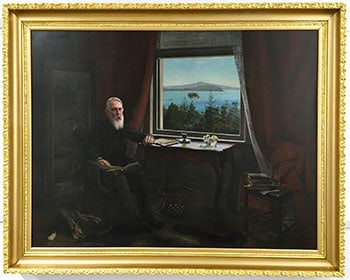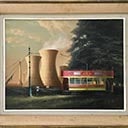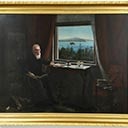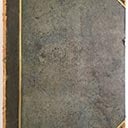Sir John Logan Campbell at Kilbryde, Parnell
110 x 140 cm
est. $300,000 - 500,000
 Relative size
Relative size
Provenance:
Private Collection, Auckland
Sir John Logan Campbell's reputation precedes him. From the time of his arrival in New Zealand in 1840, he established himself as a central figure in his local community. This was a man whose ambition and far reaching endeavours contributed greatly to Auckland's economic and cultural flourishment throughout the 19th century: for this reason, he is fondly remembered as the founding Father of Auckland.
This splendid portrait of Campbell by Louis John Steele was painted in the early 20th-century and it is only now, over a century later, that the painting is making its first public appearance. Previously, the only known record of its existence was a studio photograph taken of Steele, proudly sitting in front of the major work.
By the time the portrait was completed, Campbell's legacy was well-established. He had recently been appointed Mayor of Auckland in an honorary capacity (for the period of the Duke and Duchess of Cornwall's visit), and used this opportunity to gift the significant landholding of Cornwall Park - so named at the time of donation - to the city.
Striking in its grandeur, this painting has all the characteristic traits of a portrait conceived in the grand historic tradition. Steele completed his artistic training between London, Paris and Florence, and the influence of these 19th-century schools on his style is evident. The scale of the work is particularly striking, and it conveys an academic seriosity and artistic ambition. Campbell is likely to have been around 90-years of age at the time he sat for this portrait, there is a sense of distinction in the way Steele has depicted him. His posture is upright; his demeanour both pensive and alert as he gazes beyond the picture plane. The formal arrangement, with a dog lying at his feet and book open on his lap, are familiar compositional devices signifying loyalty and learning.
Whilst the work draws heavily on the conventions of European formalism, it stands out in its freshness of approach. Consider, for example, the flowers on Campbell's desk. The inclusion of flowers in paintings of this genre was generally confined to the tradition of memento mori, i.e, a reminder of the transience of time, and our own mortality. The white roses on Campbell's desk defy this. They are floating in water; blossoming and very much alive. Their presence transports the viewer to a world beyond Campbell's study and home.
We gaze upon his lush Parnell estate of Kilbryde. Fittingly, a section of this property now forms part of the Parnell Rose Gardens. The roses in the portrait may be read as a living, blooming testament to Auckland's flourishment, and to the vivacity of the sitter and his legacy. In this same spirit, the harbour view from Campbell's window featuring Rangitoto, has been rendered in particularly sharp focus, suggestive of the sitter's significant contribution to the city around him.
More than anything, it is the suffusion of light, beautifully cold and soft, which seems to resonate when encountering this portrait. Casting the room into relief, Steele's skilled treatment calls to mind the luminescent interiors of Johannes Vermeer. Campbell's visage is illuminated by the natural light of his beloved Auckland city and harbour, a light which simultaneously draws our attention beyond the window, in dialogue with and appreciation of the sitter's service to the city. In this way, Steele has transcended the documentary function of portraiture and realised an important spiritual rendering of this historic New Zealand personage.
Over the course of his career, Louis John Steele was commissioned to paint a wide range of subjects and his work encompassed a number of genres. Famously, he tutored Charles Frederick Goldie and collaborated with him on a number of works including The Arrival of the Maoris in New Zealand in 1898. Portraiture comprised a significant component of Steele's practice, and this extended to various Maori subjects and prominent New Zealanders including Sir George Grey and William Garden Cowie, the Bishop of Auckland. He is believed to have completed at least six portraits of Steele in various poses. The austerity of the example in Auckland Museum's collection, painted about the same time, is in striking contrast to the gentle ode of reminiscence within this particular work. Louis Steele's portrait of Campbell is without precedent in New Zealand art history, capturing a central early Pakeha figure in the place he is eternally credited with having shaped.
References: Te Ara, The Encyclopedia of New Zealand, Louis John Steele http://www.teara.govt.nz/en/biographies/2s42/steele-louis-john Te Ara, The Encyclopedia of New Zealand, John Logan Campbell http://www.teara.govt.nz/en/biographies/1c3/campbell-john-logan R C J Stone, A Victorian Friendship and Auckland's First School of Art Art New Zealand 30, Autumn 1984 Bell, Leonard. John Logan Campbell: A Career in Images, Art New Zealand, no 67, 1993, p 88-92. Steele, Louis John, Cyclopedia of New Zealand. Volume Two: Auckland, Christchurch: Cyclopedia Company, 1902, p 21. [reproduces the portrait of Steele with the painting] http://nzetc.victoria.ac.nz/tm/scholarly/tei-Cyc02Cycl-t1-body1-d1-d35-d5.html
Our thanks to Jane Davidson-Ladd for her assistance with cataloguing of this lot. Jane is currently completing a PhD on Louis John Steele at the University of Auckland.




